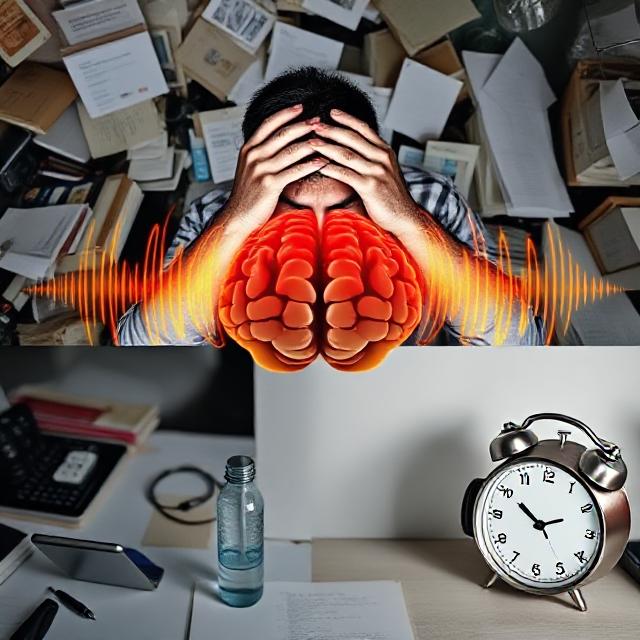
Table of Contents
Flow-Blockers: Common Habits That Kill Peak States
TL;DR
Flow—those moments of deep, effortless focus—doesn’t just depend on what you do right. It’s often destroyed by what you do wrong. From dopamine hijackers like constant notifications to nutritional imbalances, certain behaviors quietly kill your ability to enter flow. This article reveals the neuroscience behind common flow-blockers and how to eliminate them for maximum mental performance.
I. What Is Flow, Really?
Flow is a mental state where time distorts, self-awareness fades, and full attention locks into the present moment. It requires a delicate neurochemical balance:
- Dopamine: motivation and anticipation
- Norepinephrine: heightened focus
- Anandamide: pattern recognition and creativity
- Serotonin: emotional grounding
- Endorphins: euphoria and pain resistance
Flow lives in the sweet spot between challenge and skill, but it’s fragile. One wrong habit—and the whole state collapses.
II. The 7 Most Common Flow-Blockers
1. Multitasking
Flow needs uninterrupted attention. Each task switch costs your brain around 23 minutes to re-engage deeply.
- Why it breaks flow: Every switch disrupts the prefrontal cortex’s rhythm and flow neurochemicals dissipate.
- Fix it: Practice deep work sprints—45–90 minute single-task blocks, no tabs, no distractions.
2. Smartphone Dopamine Hijack
Every ping, buzz, or scroll activates dopamine without direction, leaving your brain addicted to novelty and unable to sustain effortful focus.
- Why it breaks flow: Short bursts of dopamine disrupt the gradual build-up of sustained attention.
- Fix it:
- Use focus mode or grayscale screen
- Schedule “dopamine-free” blocks
- Place phone physically out of reach
3. Lack of Clear Goals
Flow requires clear feedback loops and an understanding of what success looks like in the moment.
- Why it breaks flow: Ambiguity causes stress and overthinking, keeping your mind outside the task.
- Fix it:
- Set micro-goals like: “Finish section A by 3:00pm”
- Use checklists or timers to track progress
4. Poor Sleep and Circadian Misalignment
Your brain’s ability to reach flow depends on alertness, memory consolidation, and attention span—all tied to sleep.
- Why it breaks flow: Sleep deprivation raises cortisol and lowers dopamine sensitivity, weakening executive function.
- Fix it:
- Anchor your wake time daily
- Block blue light 2 hours before sleep
- Get morning sunlight exposure
5. Overstimulation (Noise, Clutter, Chaos)
Environments with excessive sensory input create low-level anxiety and draw focus away from your inner experience.
- Why it breaks flow: Flow depends on low external entropy so the mind can immerse without guarding attention.
- Fix it:
- Use noise-canceling headphones
- Clean your workspace before deep tasks
- Try white noise, rain sounds, or binaural beats
6. Blood Sugar Crashes and Poor Nutrition
Glucose dips or high glycemic meals impair mental clarity. Meanwhile, nutrient deficiencies like B vitamins, magnesium, or omega-3s block neurotransmitter production.
- Why it breaks flow: The brain lacks fuel and raw materials to sustain dopamine and acetylcholine cycles.
- Fix it:
- Eat balanced meals with fat, protein, and fiber
- Consider adaptogens or nootropics that support neurotransmitter balance
7. Emotional Turbulence (Anxiety, Overthinking)
Racing thoughts, doubt, or emotional volatility interfere with default mode network suppression—a necessary condition for flow.
- Why it breaks flow: Your brain can’t fully “drop into the task” if it’s busy processing internal stress signals.
- Fix it:
- Try box breathing or 5-4-3-2-1 grounding before work
- Keep a worry journal to empty emotional static
- Use music to shape your emotional landscape
III. Brainwave Breakdown: Why These Habits Matter
| Flow Blocker | Disrupts Brainwave | Effect |
|---|---|---|
| Multitasking | Alpha/theta | No rhythm formation for immersion |
| Notifications | Beta/gamma | Jittery, fragmented attention |
| No goals | Alpha | Mind wanders, no engagement |
| Sleep deprivation | Theta/gamma | Cognitive fog, poor memory |
| Noise and chaos | Alpha/theta | No entry into relaxed attention |
| Blood sugar crash | Beta | Anxiety, irritability |
| Anxiety | Gamma/theta coupling | No synchronization, scattered mental field |
Flow requires a stable alpha-theta foundation, enhanced with low gamma bursts. Every flow-blocking habit destabilizes that harmony.
IV. Flow Preservers: Tiny Habits with Big Impact
To counteract the flow-killers, introduce flow-supporting habits:
- 🔁 Flow ritual: Start your focus session with the same music, breath cue, and physical setup each time.
- 🪟 Visual clarity: Look out a window or at nature before deep work.
- 🎯 1 sentence intention: Write one actionable outcome before you begin.
- ⏲️ 90:20 rhythm: 90-minute flow block, 20-minute recharge walk.
- 💧 Hydration anchoring: Drink water every time you finish a section—keeps body and brain synced.
V. From Flow-Killers to Flow-Masters: Final Reflection
Achieving flow is not about willpower—it’s about removing friction. You don’t have to force flow. You just have to stop interrupting it.
The next time you sit down to work, ask:
- Is my phone out of sight?
- Do I know exactly what I’m doing for the next 90 minutes?
- Is my space clear, my body fueled, and my mind calm?
If the answer is yes, you’ve already cleared the runway.
All that’s left is to take off.
